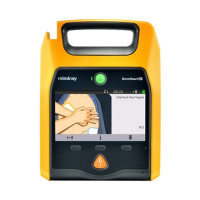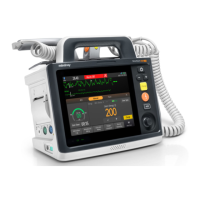Defibrillator/Monitor Operator’s Manual 5 - 5
5.4.4 ECG Measurement with External Paddles
1. Connect the paddles cable with the equipment if not connected.
2. Apply conductive gel to paddle electrodes.
3. Remove the paddle set from the paddle tray by grasping the handles and pulling them straight up.
4. Apply the external paddles to the patient by using anterior-lateral placement.
◆ Place the sternum paddle on the patient’s upper right torso, lateral to the sternum and below the
clavicle.
◆ Place the apex paddle to the patient’s left nipple in the midaxillary line, with the center of the
electrode in the midaxillary line.
N
• Anterior - lateral placement is the only placement that can be used for ECG monitoring with external
paddles.
5.4.5 Checking Paced Status
It is important to set the paced status correctly when you start monitoring ECG. The paced symbol is
displayed when the [Paced] is set to [Ye s ]. The pace pulse markers “?” are shown on the ECG wave when the
patient has a paced signal.
To change the paced status, choose either of the following ways:
■ Press the Main Menu button and select [Patient Demographics >>], set [Paced].
■ Select the ECG parameter area and select [Others >>], set [Paced].
• For paced patients, you must set [Paced] to [Yes]. If it is incorrectly set to [No], the equipment could
mistake a pace pulse for a QRS and fail to alarm when the ECG signal is too weak. Do not rely entirely
on rate meter alarms when monitoring patients with pacemakers. Always keep these patients under
close surveillance.
• For non-paced patients, you must set [Paced] to [No]. If it is incorrectly set to [Yes], the equipment
may be unable to detect premature ventricular beats (including PVCs).
• On ventricular paced patients, episodes of Ventricular Tachycardia may not always be detected.
• Do not rely entirely upon the system’s automated arrhythmia detection algorithm. Keep pacemaker
patients under close surveillance.
Sternum
paddle
Apex paddle

